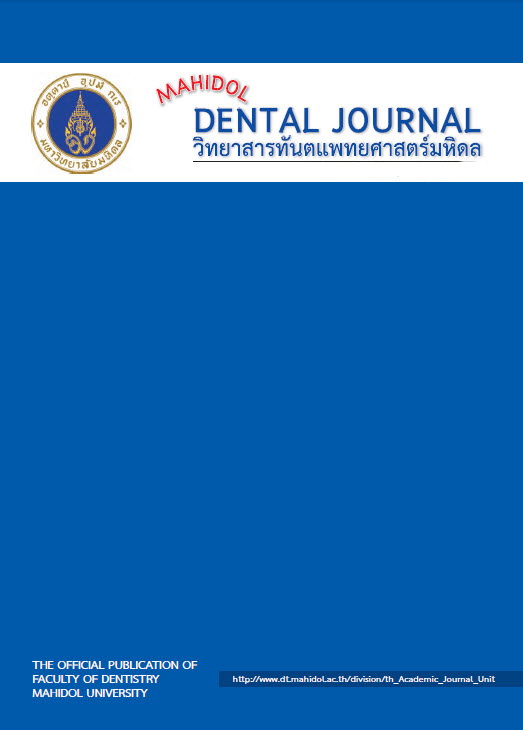Modification of curing technique of a ‘self cure’ injection molding acrylic resin: Effect on residual monomer
Main Article Content
Abstract
Objectives: To compare residual monomer levels of a heat-cure and a self-cure injection-molding denture base materials after immersing in distilled water for 7 days. The curing process of the self-cure material was modified from that recommended by the manufacturer
Materials and methods: Two denture base polymers, heat-cure SR IvocapÒ High Impact (Ivocap wet curing) and self-cure IvoBaseÒ Hybrid (IvoBase dry curing), were selected for this study, Three disc shaped specimens of each brand (50 mm. diameter 3 mm. thickness) were prepared from separate mixes. The mixing ratios and processing methods were achieved according to the manufacturer’s instruction. Modification of the curing process of IvoBase® Hybrid was achieved by wet curing at 100 OC (IvoBase wet curing). Each specimen was immersed in 37°C distilled water at 7 days. Residual monomer was extracted from the immersed specimen and determined by gas chromatography following ISO 20795-1:2013. The freshly prepared specimens were also determined for residual monomer.
Non-parametric independent sample test (Kruskal-Wallis test and Mann-Whitney U test) was used to analyze the data at a=0.05.
Results: SR IvocapÒ High Impact showed significantly higher residual monomer level than IvoBaseÒ Hybrid after 7 days water immersion. No different residual monomer level was found when IvoBaseÒ Hybrid was polymerized wet or dry. The residual monomer level of the specimens decreased when they were immersed in water 7 days compared to when they were not.
Conclusions : Different curing technique (wet and dry curing) for IvoBaseÒ Hybrid could not reduce the residual monomer level. Water immersion in SR IvocapÒ High Impact (wet curing) and IvoBaseÒ Hybrid (wet curing) significantly decrease residual monomer level. Water immersion in IvoBaseÒ Hybrid (dry curing) was no different residual monomer level.
Article Details
References
2. Kedjarune U, Charoenworaluk N, Koontongkaew S. Release of methyl methacrylate from heat-cured and autopolymerized resins: cytotoxicity testing related to residual monomer. Aust Dent J 1999; 44: 25-30.
3. Jerolimov V, Brooks SC, Huggett R, Stafford GD. Some effects of varying denture base resin polymer/monomer ratios. Int J Prosthodont 1989; 2: 56-60.
4. Stafford GD, Brooks SC. The loss of residual monomer from acrylic orthodontic resins. Dent Mater 1985; 1: 135-8.
5. Bayraktar G, Guvener B, Bural C, Uresin Y. Influence of polymerization method, curing process, and length of time of storage in water on the residual methyl methacrylate content in dental acrylic resins. J Biomed Mater Res B Appl Biomater 2006; 76: 340-5.
6. Nik TH, Shahroudi AS, Eraghihzadeh Z, Aghajani F. Comparison of residual monomer loss from cold-cure orthodontic acrylic resins processed by different polymerization techniques. J Orthod 2014; 41: 30-7.
7. Jorge JH, Giampaolo ET, Machado AL, Vergani CE. Cytotoxicity of denture base acrylic resins: a literature review. J Prosthet Dent. 2003;90(2):190-3.
8. Lung CY, Darvell BW. Minimization of the inevitable residual monomer in denture base acrylic. Dent Mater 2005; 21: 1119-28.
9. Undurwade JH, Sidhaye AB. Curing acrylic resin in a domestic pressure cooker: a study of residual monomer content. Quintessence Int 1989; 20: 123-9.
10. Yau WF, Cheng YY, Clark RK, Chow TW. Pressure and temperature changes in heat-cured acrylic resin during processing. Dent Mater 2002; 18: 622-9.
11. International Organization for Standardization. ISO 20795-1:2013[E], Dentistry – Base polymers – Part 1. ISO Geneva, Switzerland. 2013.
12. Bartoloni JA, Murchison DF, Wofford DT, Sarkar NK. Degree of conversion in denture base materials for varied polymerization techniques. J Oral Rehabil 2000; 27: 488-93.
13. Vallittu PK. The effect of surface treatment of denture acrylic resin on the residual monomer content and its release into water. Acta Odontol Scand 1996; 54: 188-92.
14. McCabe JF, Basker RM. Tissue sensitivity to acrylic resin. A method of measuring the residual monomer content and its clinical application. Br Dent J 1976; 140: 347-50.
15. Lung CY, Darvell BW. Methyl methacrylate in poly(methyl methacrylate)--validation of direct injection gas chromatography. J Chromatogr A 2004; 1061: 93-8.
16. Safety Data Sheet acc. to OSHA HCS. SR Ivocap High Impact Polymer. Ivoclar Vivadent Inc.; 2015.
17. Safety Data Sheet acc. to OSHA HCS. IvoBase Hybrid Monomer. Ivoclar Vivadent Inc.; 2015.
18. Vallittu PK, Ruyter IE, Buykuilmaz S. Effect of polymerization temperature and time on the residual monomer content of denture base polymers. Eur J Oral Sci 1998; 106: 588-93.
19. Baker S, Brooks SC, Walker DM. The release of residual monomeric methyl methacrylate from acrylic appliances in the human mouth: an assay for monomer in saliva.
J Dent Res 1988; 67: 1295-9.


